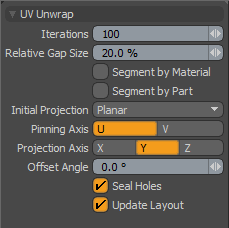UV Unwrap
Home >> The MODO Toolbox >> UV Mapping >> Unwrap Tool
The UV Unwrap tool provides an elegant solution to creating UV maps from just about any kind of mesh from hard surface to organic. To understand the concept of UV Unwrap, simply think about skinning an animal. Sure it's a little gruesome but it's really the best way to think about it. The idea is that we need to cut seams into the skin of the subject so that when we lay the skin out onto the table it lays as flat as possible without much stretching of the skin. We have just described skinning an animal and UV Unwrap all at the same time. To use UV Unwrap you will define where the model will be "cut" by selecting edges. Don't worry, this will not effect your actual mesh - it only tells the Unwrap tool where to create UV boundaries. Once you have the seams defined via the selected edges, the tool is activated. It is important to choose a good initial projection type and axis before applying the tool. Once the tool is active, dragging in the viewport increases the amount of unwrapping. At this phase you are driving a global optimization of the UV polygons so that they unfold in a uniform manner.
 Options for the tool include:
Options for the tool include:
Iterations: This value determines the number of iterations for the global solver to run across the UV data. Basically this is the "amount" of unwrap. With the value set to zero the UV view will appear just as if you simply used a UV projection method based on the Initial Projection and Projection Axis settings for the tool. Once you increase the Iterations the UV data is unwrapped.
Relative Gap Size: If your UV data has multiple contiguous pieces there needs to be some amount of gap left between these UV "chunks". The Relative Gap Size dictates how much space will be forced between the UV boundaries. Increasing this value will push the UV data further apart as well as scale the UV data down to accommodate.
Segment by Material: If you are unwrapping a contiguous mesh that has different materials assigned to various polygon groups you can use these groups to create continuous UV sections while unwrapping. This option provides a quick way to unwrap a single mesh into several UV segments which can either be left in a single UV map or pasted into separate UV maps.
Segment by Part: This option is identical to Segment by Material with the exception that it uses Part tags from the polygons.
Initial Projection: This popup choice determines how the initial UV projection will be created. The options are Planar, Cylindrical, Spherical, Use Current Map and Group Normal. The first three settings also rely on the Projection Axis.
Planar-- Planer projection will project the 3D model into UV space based on a simply plane that is projected across the model in the user defined axis.
Cylindrical--
Cylindrical creates a virtual Cylinder around the mesh
Spherical--
Spherical creates a virtual sphere for the projection. For more information about the Projection Modes see UV Create Tool.
Use Current Map--
The Use Current Map option uses the current state of the UV map as a starting point rather than projecting new UVs. This is very useful if you already have created some reasonable UV map and want to use Unwrap to further refine the UVs without destroying your hard work.
Group Normal-- Group Normal uses the average normal of the selected polygons to determine the initial projection plane. This can be useful on geometry that is mostly facing the same direction but will give less than useful results when the mesh is complex and has many overlapping areas. If you want to see in 3D the axis that would be chosen for the Group Normal option you can hover your mouse over the 3D viewport and press Ctrl-A. This will align the viewport to the average normal of the selected polygons.
Pinning Axis: The Pinning Axis determines the UV axis to favor when shuffling the UV boundaries during the unwrap. U is the horizontal axis and V is vertical.
Offset Angle: This value allows you to add some rotation to the resulting unwrapped UVs. This can be very useful if your original mesh is not world axis aligned. By adjusting this value you can see in real time the effect on the map.
Seal Holes: If your mesh is not "water tight" (such as a head with open eye sockets) the Unwrap algrithm can sometimes have difficulty resolving these areas. The Seal Holes option will create a virtual polygon to close the holes and improve the unwrapping effect.
Update Layout: This option forces the UV layout to remain within the 0 to 1 UV coordinate space.
